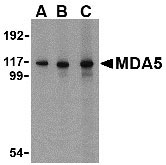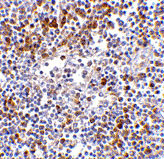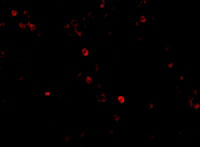MDA5 Antibody
- 产品详情
- 实验流程
- 背景知识
Application
| WB, IF, E, IHC-P |
|---|---|
| Primary Accession | Q9BYX4 |
| Other Accession | NP_071451, 27886568 |
| Reactivity | Human, Mouse |
| Host | Rabbit |
| Clonality | Polyclonal |
| Isotype | IgG |
| Calculated MW | 116689 Da |
| Concentration (mg/ml) | 1 mg/mL |
| Conjugate | Unconjugated |
| Application Notes | MDA5 antibody can be used for detection of MDA5 by Western blot at 1 - 4 µg/mL. Antibody can also be used for immunohistochemistry starting at 5 µg/mL. For immunofluorescence start at 20 µg/mL. |
| Gene ID | 64135 |
|---|---|
| Other Names | MDA5 Antibody: Hlcd, MDA5, MDA-5, RLR-2, IDDM19, RH116, Interferon-induced helicase C domain-containing protein 1, Clinically amyopathic dermatomyositis autoantigen 140 kDa, CADM-140 autoantigen, interferon induced with helicase C domain 1 |
| Target/Specificity | IFIH1; |
| Reconstitution & Storage | MDA5 antibody can be stored at 4℃ for three months and -20℃, stable for up to one year. As with all antibodies care should be taken to avoid repeated freeze thaw cycles. Antibodies should not be exposed to prolonged high temperatures. |
| Precautions | MDA5 Antibody is for research use only and not for use in diagnostic or therapeutic procedures. |
| Name | IFIH1 (HGNC:18873) |
|---|---|
| Function | Innate immune receptor which acts as a cytoplasmic sensor of viral nucleic acids and plays a major role in sensing viral infection and in the activation of a cascade of antiviral responses including the induction of type I interferons and pro-inflammatory cytokines (PubMed:28594402, PubMed:32169843, PubMed:33727702). Its ligands include mRNA lacking 2'-O-methylation at their 5' cap and long-dsRNA (>1 kb in length) (PubMed:22160685). Upon ligand binding it associates with mitochondria antiviral signaling protein (MAVS/IPS1) which activates the IKK-related kinases: TBK1 and IKBKE which phosphorylate interferon regulatory factors: IRF3 and IRF7 which in turn activate transcription of antiviral immunological genes, including interferons (IFNs); IFN-alpha and IFN-beta. Responsible for detecting the Picornaviridae family members such as encephalomyocarditis virus (EMCV), mengo encephalomyocarditis virus (ENMG), and rhinovirus (PubMed:28606988). Detects coronavirus SARS-CoV-2 (PubMed:33440148, PubMed:33514628). Can also detect other viruses such as dengue virus (DENV), west Nile virus (WNV), and reovirus. Also involved in antiviral signaling in response to viruses containing a dsDNA genome, such as vaccinia virus. Plays an important role in amplifying innate immune signaling through recognition of RNA metabolites that are produced during virus infection by ribonuclease L (RNase L). May play an important role in enhancing natural killer cell function and may be involved in growth inhibition and apoptosis in several tumor cell lines. |
| Cellular Location | Cytoplasm. Nucleus. Mitochondrion. Note=Upon viral RNA stimulation and ISGylation, translocates from cytosol to mitochondrion. May be found in the nucleus, during apoptosis |
| Tissue Location | Widely expressed, at a low level. Expression is detected at slightly highest levels in placenta, pancreas and spleen and at barely levels in detectable brain, testis and lung |
For Research Use Only. Not For Use In Diagnostic Procedures.
Provided below are standard protocols that you may find useful for product applications.
BACKGROUND
MDA5 Antibody: The innate immune system detects viral infection by recognizing various viral components and triggers antiviral responses. Like the toll-like receptor 3 (TLR3), the melanoma differentiation-associated protein 5 (MDA5) recognizes double-stranded (ds) RNA, a molecular pattern associated with viral infection. MDA5, a member of the DEAD/DEAH-box RNA helicase family, consists of an amino-terminal caspase recruitment domain (CARD) and a carboxyl-terminal RNA helicase domain similar to that of the related protein RIG-1. When stimulated by dsRNA, MDA5 recruits the adaptor protein VISA and ultimately causes the activation of IRF-3 and NF-κB. MDA5 and RIG-1 recognize different types of dsRNA, with MDA5 recognizing poly (I:C). MDA5-null mice were highly susceptible to infection with picornaviruses, which possess such sequences, demonstrating the importance of MDA5 in innate immunity.
REFERENCES
Akira S, Uematsu S, and Takeuchi O. Pathogen recognition and innate immunity. Cell 2006; 124:783-801.
Hiscott J, Nguyen T-LA, Arguello M, et al. Manipulation of the nuclear factor-kappaB pathway and the innate immune response by viruses. Oncogene 2006; 25:6844-67.
Kang D, Gopalrishnan RV, Lin L, et al. Expression analysis and genomic characterization of human melanoma differentiation associated gene-5, mda-5: a novel type I interferon-responsive apoptosis-inducing gene. Oncogene 2004; 23:1789-800.
Andrejeva J, Childs KS, Young DF, et al. The V proteins of the paramyxoviruses bind the IFN-inducible RNA helicase, mda-5, and inhibit its activation of the IFN-beta promoter. Proc. Natl. Acad. Sci. USA 2004; 101:17264-9.
终于等到您。ABCEPTA(百远生物)抗体产品。
点击下方“我要评价 ”按钮提交您的反馈信息,您的反馈和评价是我们最宝贵的财富之一,
我们将在1-3个工作日内处理您的反馈信息。
如有疑问,联系:0512-88856768 tech-china@abcepta.com.























 癌症的基本特征包括细胞增殖、血管生成、迁移、凋亡逃避机制和细胞永生等。找到癌症发生过程中这些通路的关键标记物和对应的抗体用于检测至关重要。
癌症的基本特征包括细胞增殖、血管生成、迁移、凋亡逃避机制和细胞永生等。找到癌症发生过程中这些通路的关键标记物和对应的抗体用于检测至关重要。 为您推荐一个泛素化位点预测神器——泛素化分析工具,可以为您的蛋白的泛素化位点作出预测和评分。
为您推荐一个泛素化位点预测神器——泛素化分析工具,可以为您的蛋白的泛素化位点作出预测和评分。 细胞自噬受体图形绘图工具为你的蛋白的细胞受体结合位点作出预测和评分,识别结合到自噬通路中的蛋白是非常重要的,便于让我们理解自噬在正常生理、病理过程中的作用,如发育、细胞分化、神经退化性疾病、压力条件下、感染和癌症。
细胞自噬受体图形绘图工具为你的蛋白的细胞受体结合位点作出预测和评分,识别结合到自噬通路中的蛋白是非常重要的,便于让我们理解自噬在正常生理、病理过程中的作用,如发育、细胞分化、神经退化性疾病、压力条件下、感染和癌症。








